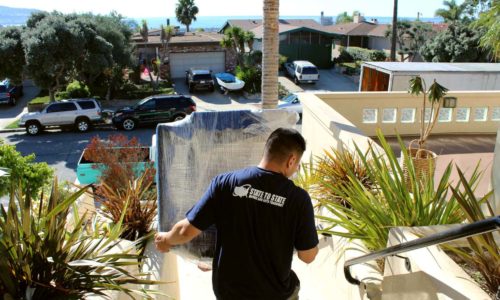Moving to another state to start over can be both an exhilarating and challenging experience. It symbolizes a fresh start but also involves considerable planning and organization. When you’re moving state to state, it’s crucial to have a strategic approach. We want to introduce you to essential tips and strategies to ensure your interstate relocation is as smooth and efficient as possible. Let’s begin this incredible journey together.
What should you know about how to start over in a new state? Starting afresh in a different area involves both logistical preparation and emotional readiness. Learning about the area’s cost of living, employment landscape, and lifestyle is vital. Establishing a realistic budget and savings plan helps in managing the financial aspects of this transition. Legal tasks, such as updating personal documents and understanding regional laws, are also crucial. Once settled, building a social network and familiarizing oneself with local amenities facilitates quicker adaptation. Emotionally, it’s important to be open to change and seek support when needed.
Deciding on Moving to Another State to Start Over – The First Step
Deciding to start over in a new state is a significant life decision, intertwined with both emotional aspects of moving and practical considerations.
It’s not just about packing boxes and finding a different home. It involves assessing reasons for a fresh start.
The emotional journey can be complex, ranging from the excitement of new opportunities to the apprehension of leaving familiar surroundings.
This process often includes dealing with relocation stress, which is a common but sometimes overlooked aspect of moving.
It’s important to acknowledge and prepare for the psychological impact of starting over in a different place, as it can be a profound and even traumatic experience for some. Understanding and addressing these emotional and practical aspects is crucial in making a well-informed decision.
Research Everything About the New Destination
When considering a move to a new state, thorough research is essential to ensure a smooth transition. Key factors include the cost of living, employment opportunities, and the overall lifestyle in another home. Preparing for movers is just one piece of the puzzle. Knowing the benefits of moving to a particular state can greatly influence your decision.
Utilizing online resources, such as the Numbeo website, can provide valuable insights into new state living expenses, helping you to compare and contrast different areas. It’s also beneficial to tap into local networks, either online or through personal connections, to gain in-depth information about the area. This research can inform you about the economic environment, social scene, and other day-to-day realities.

Create a Budget and Start Saving Money
Creating a budget and starting to save money is a crucial step in the relocation process. Relocation budget planning requires a realistic assessment of all potential moving costs, which includes everything from hiring state-to-state movers to the unforeseen expenses that often arise when you start over in a new city.
To save money to relocate, look for cost-saving tips like decluttering before the move, comparing relocation company quotes, or considering a DIY approach where feasible. Remember, the costs extend beyond the physical move. Setting up a home and adapting to a new environment can also impact your finances. Therefore, having an emergency fund is vital for unexpected expenses.
Find a Place to Live Before Leaving the Old Home
Ensuring a different residence is secured before departing from an old one can greatly facilitate the transition into an unfamiliar setting. Effective strategies for remote house hunting include leveraging digital tools to explore potential neighborhoods that align with lifestyle and budget needs.
Utilizing online real estate platforms such as Zillow and Trulia and engaging with local real estate agents can provide a deeper understanding of available options. Consider factors like commute, amenities, and the overall community atmosphere. Virtual tours are invaluable for gaining a sense of the space without being physically present.
Renting vs. Buying Considerations in a New State
Determining whether to rent or buy in a fresh location hinges on long-term intentions and financial readiness. Renting offers more flexibility, especially when exploring different areas or if a long-term commitment isn’t feasible.
Make a comprehensive checklist for potential rentals to ensure they meet essential requirements. Focus on amenities, lease conditions, and maintenance obligations. Conversely, purchasing may be more suitable for people seeking permanence and who are prepared for a significant financial commitment.
Engage in virtual tours and remote negotiations to get acquainted with the housing market. Collaborating with a local real estate expert can simplify the process, offering market insights and assisting with documentation and negotiations for moving to another home.

Organize the Move – Logistics and Timing
Organizing a relocation, especially when it involves relocating away and starting over in a new state, requires meticulous planning and coordination. Creating a relocation timeline and checklist is an essential part of this process. Begin by outlining all the tasks that need to be completed, from the initial stages of finding a different destination to the final steps of settling in.
This timeline should include important milestones like when to start researching relocation services, finalizing housing arrangements, and notifying relevant parties such as employers, schools, and utility providers about the change in address. Efficient organization ensures that each step is methodically approached, reducing the likelihood of overlooked details.
How to Make an Easy-to-Follow Checklist
To create an efficient and effective relocation checklist for a fresh start, begin by breaking down the process into manageable tasks. Start with early preparations, like researching and deciding on a long-distance moving company, and progress to more immediate needs as the date approaches.
The relocation checklist should cover every aspect of the transition, including the sorting and disposal of items, finalizing travel arrangements, and setting up services. Include a timeline for each task to avoid last-minute relocation chaos. This structured approach not only ensures that all necessary steps are taken care of promptly but also helps in maintaining a sense of control.

Choose a Long-Distance Moving Company
When planning an interstate relocation, choosing a reliable long-distance moving company is a pivotal step in ensuring a smooth transition. To find a trustworthy mover, start by conducting thorough research. Seek recommendations from friends or family who have undergone similar experiences and who have invested in relocating and packing services.
Online resources, especially the Better Business Bureau website, can provide valuable insights into a company’s reputation and customer feedback. When you choose a company, look for those with extensive experience in long-distance relocations, as they are more likely to understand the complexities and challenges of your intention to move away and start over.
Check their licensing and insurance to ensure they’re legally compliant and capable of protecting all belongings. Request detailed quotes from multiple companies to compare long-distance moving services and costs.
If you want to be sure that you don’t fall victim to moving scams, please watch this video.
Learn How to Handle Legal and Administrative Tasks
One of the primary legal tasks for state relocation is updating identification documents and registrations, such as driver’s licenses, vehicle registrations, and voter registrations. This requires a visit to the local DMV or utilizing their online services.
Additionally, it’s crucial to organize important documents and ensure they are easily accessible during the transition. Transferring or acquiring new insurance policies, including health, auto, and property insurance, is another essential step.
Each state has different insurance requirements and providers, so thorough research and timely updates are necessary. Understanding the tax implications in another location is also important. This may include differences in state income tax, property tax, and any other relevant fiscal policies.

Settling Into the New Home
Settling into a new home involves adjusting to a new environment and making the space your own. An apartment checklist can be invaluable in this process, ensuring that essential tasks, from setting up utilities to purchasing necessary household items, are completed efficiently. Here is a list of essential tasks that shouldn’t be neglected during this period:
- Unpack and organize – Utilize a new apartment checklist to systematically unpack and organize belongings. This can help in efficiently setting up the space after moving interstate.
- Small space solutions – For those in smaller homes, implementing small apartment ideas, such as using space-saving furniture and smart storage solutions, is key to maximizing and efficiently using the available space.
- Build a social network – Actively work on building a different social network and community ties. This could involve joining local groups, participating in community events, or simple acts like meeting neighbors.
- Explore local amenities – Take time to explore the surroundings. Discover local parks, restaurants, cultural spots, and other amenities. This exploration helps in adjusting to a different environment and forming a connection with the area.
Pay Attention to Your Emotional Well-Being During the Transition
Relocating and reinventing life in a new state can bring significant emotional challenges. It’s not uncommon to experience feelings of loneliness, disorientation, or even adjustment insomnia as you adapt to a new environment.
Paying attention to your emotional well-being during this time is crucial. Seek out support systems, whether they be acquaintances in the state, online communities, or keeping regular contact with friends and family back home.
Remember, it’s normal to feel a range of emotions during this time. Embracing change and focusing on personal growth can help with navigating these feelings more effectively. Engage in activities that you enjoy and that give you a sense of fulfillment.
Trust State-To-State Movers to Get Your Belongings Safely to Another Destination
From the initial planning and organizing stages, where you create a detailed checklist and timeline, to choosing the right long-distance moving company, each step plays a crucial role in ensuring a smooth transition. Handling legal and administrative tasks, such as updating documents and understanding new state regulations, is vital in establishing a solid foundation in the new location. Once you arrive, building local networks and exploring your surroundings contribute to a seamless adjustment.
By following these key steps and leveraging the expertise of State2State Movers, you can confidently navigate the complexities of the relocation. For a move that combines efficiency with peace of mind, contact us, State2State Movers.
FAQ
How Do I Choose the Right State for My Fresh Start?
Consider factors like climate preferences, employment opportunities, cost of living, and proximity to family or desired amenities. Research online, visit prospective areas if possible, and consider the lifestyle and cultural aspects of each location.
How Can I Efficiently Plan My Move to Minimize Stress?
Develop a detailed timeline and checklist for all tasks. Prioritize the organization of documents, research professional services for long-distance transitions, and ensure legal and administrative tasks are managed well in advance.
How Can I Quickly Adapt to My New Environment and Community?
Engage actively in local activities, join clubs or groups that align with your interests, and explore various parts of the area. Building connections with neighbors and community members can also facilitate quicker adaptation.
What Should I Prioritize During the First Month in My New State?
Focus on setting up essential services and completing any remaining administrative tasks. Explore local amenities, establish a daily routine, and start building social connections in the community.
How Do I Handle Homesickness After Moving?
Stay connected with friends and family through regular calls or online communication. Create a comforting personal space that includes familiar items. Engaging in familiar activities can also help in coping with homesickness.
What Are the Best Ways to Find Employment in a New State?
Utilize online job portals, networking platforms like LinkedIn, and local employment agencies. Attend job fairs, and consider reaching out to local professional groups or associations related to the field of work.
How Can I Maintain Long-Distance Relationships With Friends and Family?
Regular communication through calls, texts, and video chats is key. Plan visits when possible, and consider scheduling virtual hangouts or activities. Sharing experiences and updates helps in maintaining strong connections.















